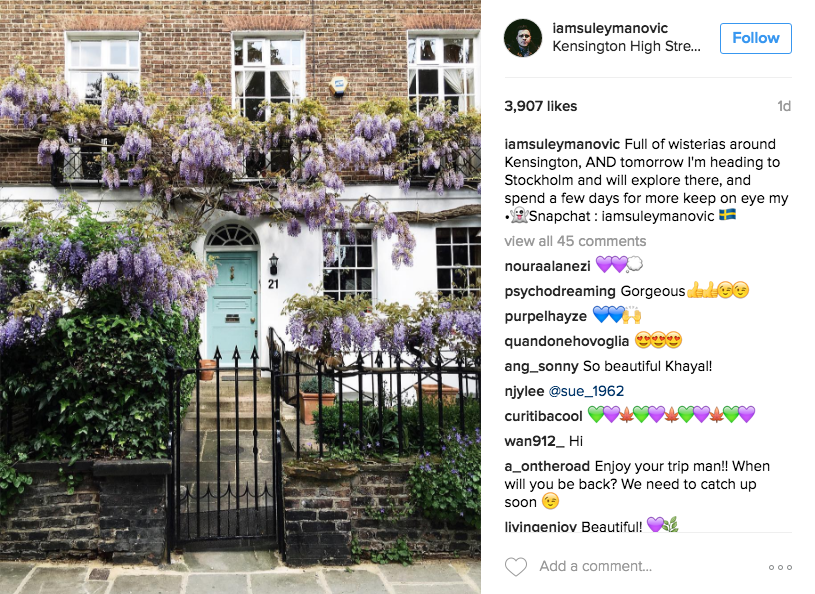
It doesn’t take long for a conversation in London to end up at real estate. Soaring housing costs make property the go-to topic for the city and beyond.
It’s no surprise then that there’s a burgeoning new outlet: Instagram. Former Vogue content manager Emma Geary a year ago started @MewsingsLdn, devoted to images of “mews” (rows of houses) from London, with a few sprinkled in from Brighton and Edinburgh. Property porn at its finest.
In the last year, accounts focused on fabulous facades have grown followers up to the high thousands. Mostly, they aggregate images, acting as a repository for beautiful buildings in London, like @HousesofLdn which 25,000 followers. @PrettyLittleLondon launched seven months ago by Andrea Di Filippo and his girlfriend as an alternative tourist guide, showcasing hidden houses and streets. “We were sick of seeing so many pictures of Big Ben and The Shard,” he said. It now has 80,000 followers.
Buying a house in London, now an impossible dream for most young people, makes poring over property porn an aspirational past time. Instagram is a great democratizer; anyone can take a picture of the outside of a house. There have been 777,000 posts on Instagram using the hashtag #property, with a further 5,000 using #propertyporn and 9,000 using #HouseGoals.
This aspirational bent is also reminiscent of how we view luxury fashion. Allen Hull, client strategy director at social media agency 1000heads, points to the Instagram effect which has contributed to the rise in popularity in properties on Instagram; research — admittedly from Facebook — that finds when an image is posted on Instagram rather than another platform, it’s perceived as more imaginative, creative and inspiring.
These accounts tend to reinforce a quintessential view of London (one of the MewsingLdn posts that regularly gets a lot of engagement is featured in the Richard Curtis film “Love Actually”).
“If you have a niche or a nuance, people can get behind that,” said Emma Geary, creator of MewsingLdn. “Pictures of Christmas wreaths are really popular, and hashtags on door knockers or challenges like #neighbourhoodnumbers,” (posting the most creative images around door numbers for a month).

“We’ll see more estate agents leveraging platforms like Instagram, putting a more creative and emotive lens on the real estate world,” believes Hull.
A platform like Pinterest acts like a digital wish list where behavior of it is driven much more by intent; whereas, Instagram captures moments and experiences. It’s this that estate agents would need to understand, Hull said.
“They would need to reflect the other behaviors that you see on the platform, so capturing moments around an area, the local environment, social venues, people on the street, using Instagram carousel,” he said. “And partnering with influencers or people from that area is a way do to it.”
Main image: Housesofldn via Instagram.
More in Marketing

TikTok pushes deeper into AI-powered ads amid uncertainty over U.S. ban
TikTok has big plans for Smart+ and search this year, despite its ongoing legal battle.

Sam’s Club sees initial success with digital checkout
Sam’s Club’s CFO said at an investment conference that “if we fast forward into the future,” there will probably be no checkout registers.

How employment is projected to transform in media during the AI era
Experts offer pointers on how to future-proof your career or re-enter the job market in a period of disruption.





